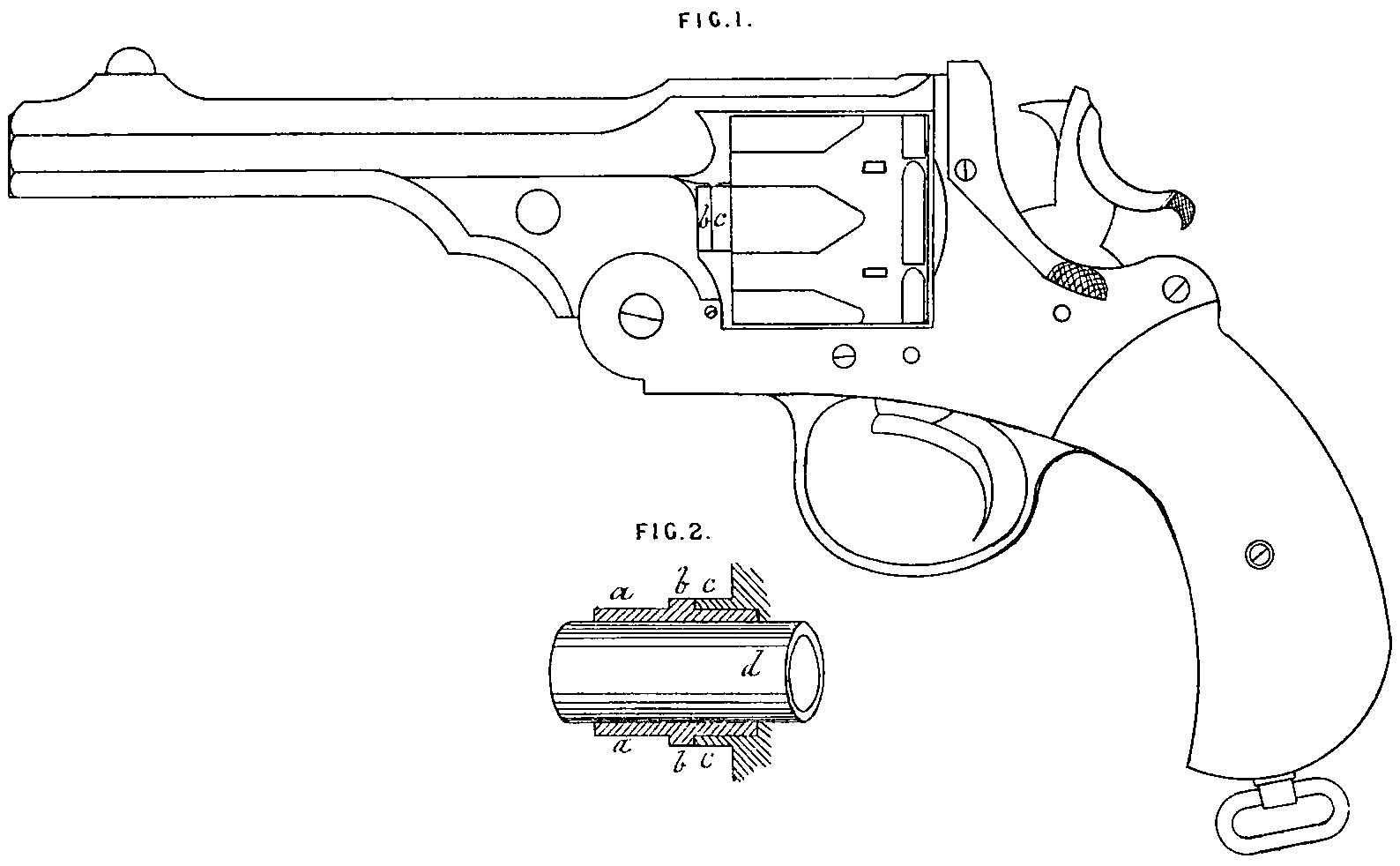Britain 1923
A.D. 1886, 10th February. № 1923.
PROVISIONAL SPECIFICATION.
Improvements in Revolving Firearms.
I William John Whitting, of Whateley Road, Handsworth, in the County of Stafford, Toolmaker do hereby declare the nature of this invention to be as follows:—
The object of this invention is to prevent the fouling, which arises from the flash, from reaching the spindle upon which the cylinder of a revolver turns, as the eH’cct of the fouling on the spindle and cylinder is to retard and finally stop the revolution of the cylinder, and render the firearm unusable until it has been stripped.
My improvements consist in the addition of two short cylindrical guards or ferules, one overlapping the other, in such a way as to prevent the fouling from getting to the spindle.
To apply my improvements I cut sway a part of the lump under the barrel, so that the breech end of the barrel projects further back than the said lump.
Into this lump the hole for the cylinder spindle is bored in the ordinary way, but the upper part of the bore is enlarged. A ferule, having on it a raised collar, is then fitted into the enlarged portion of the bore, the collar being outside the bore. This ferule has a part, smaller than the raised collar, projecting backwards about as far as the rear end of the barrel.
This ferule is bored right through, and the spindle fits into and through it.
On the cylinder proper is another ferule, which fits easily over the reduced projecting part of the ferule affixed to the lump, forming a sleeve or guard over part of the first ferule. This cylinder ferule extends so far as nearly to touch the raised collar on the first ferule.
The result of this arrangement, is that the spindle is covered from the flash, and the only joint at which fouling could enter, namely at the point where the cylinder ferule nearly touches the raised collar on the first described ferule, is out of the line of the flash.
Further, if any fouling did enter at this joint, it would have to afterwards turn three right angles before it could foul the spindle.
As an additional safeguard I also form a raised collar on the outer circumference of the cylinder ferule, to break the course of any portion of the flash which may turn along the said ferule.
Dated this 9th day of February 1886.
J. BEVERLEY FENBY,
Agent for the Applicant.
COMPLETE SPECIFICATION.
Improvements in Revolving Firearms.
I William John Whitting, of Whateley Road, Handsworth, in the County of Stafford, Tool Maker, do hereby declare the nature of my invention for Improvements in Revolving Firearms and in what manner the same is to be performed, to be particularly described and ascertained in and by the following statement:—
The object of this invention is to prevent the fouling, which arises from the flash, from reaching the spindle upon which the cylinder of a revolver turns, as the effect of the fouling on the spindle and cylinder is to retard and finally stop the revolution of the cylinder, and render the firearm unusable until it has been stripped.
My improvements consist in the addition of two short cylindrical guards or ferules, one overlapping the other, in such a way as to prevent the fouling from getting to the spindle.
To apply my improvements I cut away a part of the lump under the barrel, so that the breech end of the barrel projects further back than the said lump.
Into this lump the hole for the cylinder spindle is bored in the ordinary way, but the upper part of the bore is enlarged.
A ferule, having on it a raised collar, is then 6tied into the enlarged portion of the bore, the collar being outside the bore.
This ferule has a part, smaller than the raised collar, projecting backwards about as far as the rear end of the barrel. This ferule is bored right through, and the spindle fits into and through it.
On the cylinder proper is another ferule, which fits easily over the reduced projecting part of the ferule affixed to the lump, forming a sleeve or guard over part of the first ferule.
This cylinder ferule extends so far as nearly to touch the raised collar on the firs ferule.
The result of this arrangement is that the spindle is covered from the flash, and the only joint at which fouling could enter, namely at the point where the cylinder ferule nearly touches the raised collar on the first described ferule, is out of the line of the flash.
Further, if any fouling did enter at this joint;, it would have to afterwards turn three right angles before it could foul the spindle.
In the accompanying drawing, Fig. 1 shews a revolver fitted with my improvements, and Fig. 11 shews the ferules to an enlarged scale. Like letters refer to like parts in both Figs. 11 is the first described ferule, fitted into the lump beneath the barrel, and b is the raised collar on the same. d is the spindle passing through the ferules. c is the second ferule, attached to the revolving cylinder.
Having now particularly described and ascertained the nature of my said Invention, and in what manner the same is to be performed, I declare that what I claim is:—
Fitting to revolvers the overlapping ferules or guards as described end illustrated For the purpose of preventing the fouling from the flash from retarding the revolution of the cylinder.
Dated this 31st day of August 1886.
WILLIAM JOHN WHITING

